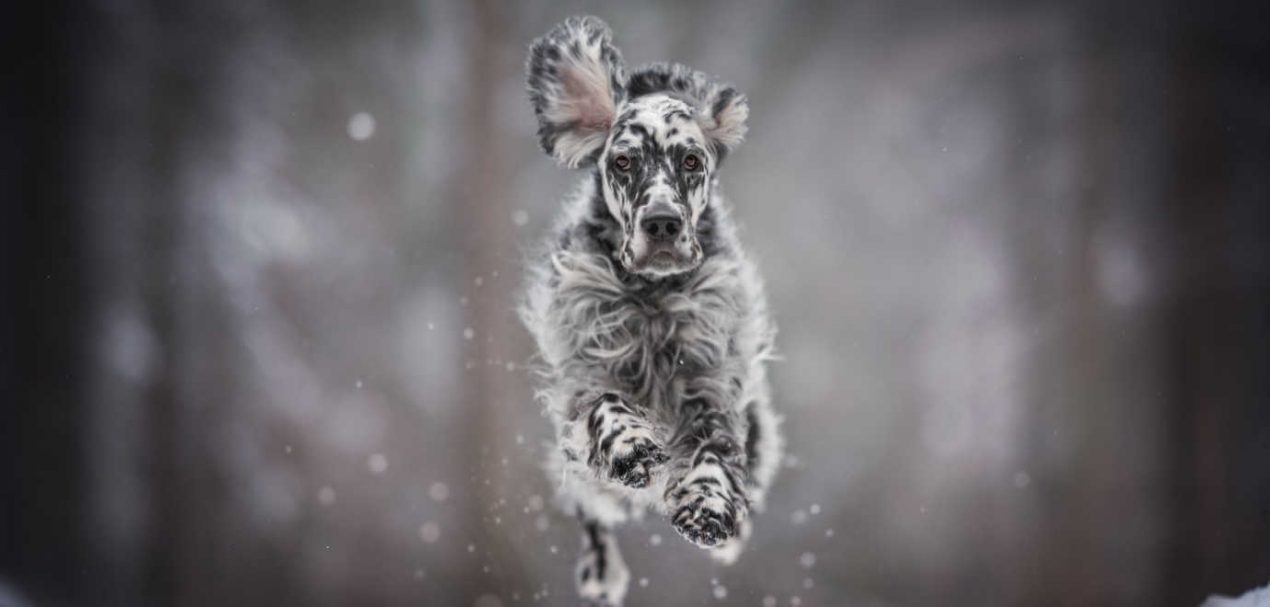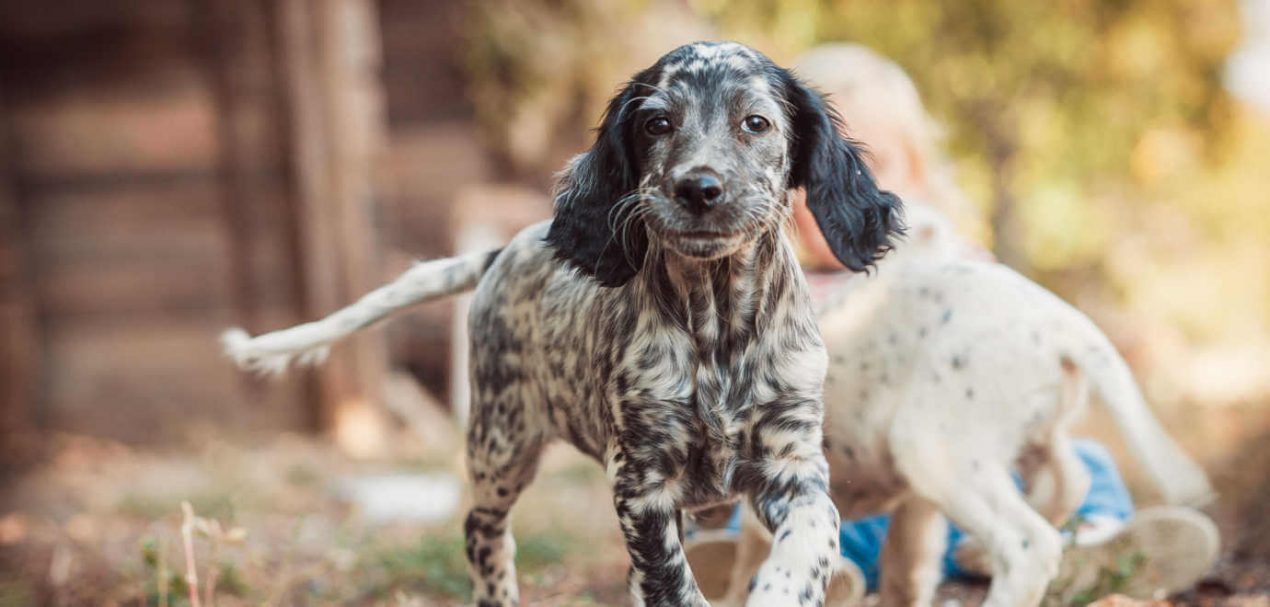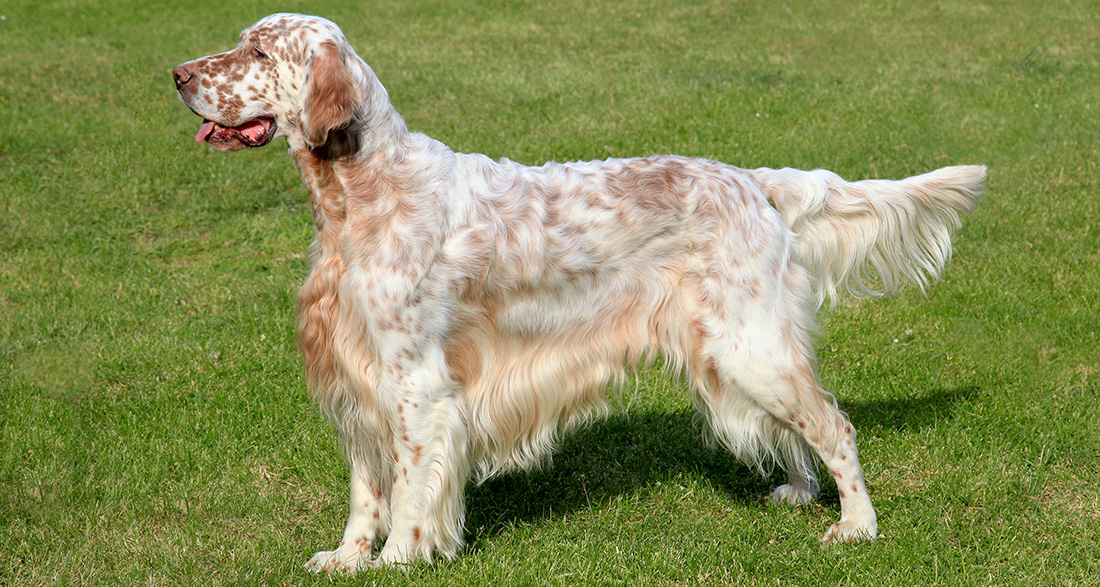The English Setter is an English dog breed specifically bred for hunting. Recognized by the FCI (Fédération Cynologique Internationale) since 1963, this medium-sized breed falls under Group 7: Pointing Dogs, Section 2: British and Irish Pointers.
History And Origin
As the name suggests, the English Setter originates from England and was mainly used as a hunting dog in the Middle Ages. These long-haired dogs specialized in bird hunting. With their sensitive nose, they could easily track down partridges. However, in addition to their good hunting performance, Setters were also bred for their beautiful appearance and stable nature.
In the 19th century, Sir Edward Laverack was the first to start breeding the English Setter and selected the most beautiful and best performing dogs for his breed. It was not until 1860 that it became a breed in its own right.
The English Setter is an excellent hunter and can sniff out game from a great distance thanks to its sensitive nose. The breed is also very obedient, which is an advantage when hunting. This is because the Setter can flush out game on command and retrieve the carcass after it has been shot.
Due to its elegant appearance, the English Setter has also become increasingly popular in private households and has almost become a fashion dog due to its special markings in the coat.
Breed Overview
GROUP: Sporting
HEIGHT: 25 to 27 inches (male); 23 to 25 inches (female)
WEIGHT: 65 to 80 pounds (male); 45 to 55 pounds (female)
TEMPERAMENT: Affectionate, energetic, lively, independent, playful
COAT: Flat, silky, medium-length single coat, with feathering on the ears, abdomen, chest, legs, and tail
COAT COLOR: White coat base with belton markings including flecks or intermingled roan (belton colors include orange, lemon, liver, blue, and tri-color)
HYPOALLERGENIC: No
LIFE SPAN: 10 to 12 years

Temperament and Character
The English Setter is one of the friendliest family dogs. This is because, when he is busy, he is loving, even-tempered and affectionate towards his family in the house. Aggression is a foreign word to the English Setter. His friendly and gentle nature means he gets on well with children. This sensitive four-legged friend needs close human contact and finds it difficult to be alone.
However, the English Setter can also be temperamental, eager to perform and independent. It needs plenty of exercise, a consistent hand and definitely a task. Daily exercise of mind and body is vital for him. He is intelligent and docile and masters set tasks with ease. However, he is by no means a beginner’s dog.
| Affection Level | High |
| Friendliness | High |
| Kid-Friendly | High |
| Pet-Friendly | High |
| Exercise Needs | High |
| Playfulness | High |
| Energy Level | Medium |
| Trainability | Medium |
| Intelligence | High |
| Tendency to Bark | Low |
| Amount of Shedding | Medium |
Acquiring an English Setter
Many dog lovers fall in love with the English Setter’s great character and beautiful appearance. If you are thinking about getting one of these dogs, you should first consider whether you are up to the challenge of keeping this hunting dog in a species-appropriate manner. In any case, you will need enough time to spend with the English Setter and give it a task that will fulfill its life. Ideally, you should be a hunter yourself or very sporty. The English Setter needs an active owner who, ideally, already has experience with hunting dogs.
The arrival of a puppy will change at least the next 10 years. This hunting dog demands the whole time of its owner and its family right from the start. If you feel up to this “strenuous” addition, you are sure to find a loyal companion for life in an English Setter. If you are sporty and have fallen in love with this special breed of dog, but don’t have the confidence to train it, you can look for an adult English Setter at an animal shelter or animal welfare organization.
What to Consider When Buying?
When buying an English Setter puppy, you should choose a local breeder. You can obtain information about reputable breeders from the AKC (American Kennel Club). You should definitely talk to the breeder about the puppy’s health care and ask to see a pedigree. When looking for an English Setter, it is also a good idea to contact Setter or Jadghund clubs, which may also be able to refer you to a good breeder or to reputable placement sites.
A reputable breeder will usually explicitly request a visit from you to see the “nursery”, including the mother, which is quite normal. Experienced breeders don’t just want to sell dogs, they want to get an idea of the future home and whether the puppy will suit the new owners. It is therefore quite possible that you will also be confronted with a few questions.
The puppies are handed over after the 8th week at the earliest, with all the important documents, their usual food ration and a personal blanket. But now to an important question: How much does an English Setter cost? The purchase price starts at around $700 to $1000 and can vary upwards.
Development and Training of the Puppy
English Setter puppies are very smart, learn very quickly and are easy to motivate for training due to their cheerful nature. However, they are also real bundles of energy, which is why they are often unfocused and prefer to romp around. It is therefore very important that you approach the puppy with patience and consistency.
You can also work him out before training so that he can concentrate better on the training afterwards. With the English Setter, a close bond with your puppy is particularly important from an early age and should be encouraged.
It is a great challenge for beginners in particular to cope well with so much energy. You should therefore definitely have some dog experience.

How to Keep an English Setter?
A small city apartment without a garden is rather unsuitable for this Dog Breed, unless you are out and about with him for hours every day and give your dog sufficient exercise. A house with a large garden is definitely much more suitable. He does not like to be left alone at home. However, with sufficient mental and physical activity, he can be left alone for a while.
Is the English Setter a family dog? If you are an active family that likes to be outdoors, the answer to this question is yes and you will find this dog breed a great partner for the whole family.
Activities
The English Setter is a hunting dog and has a lot of stamina and energy. This sporting dog needs plenty of exercise in the fresh air. It is therefore ideal for hiking, jogging, cycling or riding. Day trips are no problem for this sporty dog.
As the English Setter was bred for hunting, it has a very pronounced hunting instinct and should always be kept an eye on. If you use a suitable dog lead, you are on the safe side from the English Setter’s “hunting activities”. Of course, it would be ideal if you were to lead the English Setter on a hunt.
Grooming and Care
The English Setter has a long and silky coat, which requires special care. The coat should ideally be brushed daily so that it does not become matted. You should also clean the coat thoroughly every time after a walk and remove dirt and twigs.
You do not need to bathe your English Setter, or only very rarely. It is usually sufficient to brush the dirt out of the coat. You should also check and clean your English Setter’s floppy ears regularly.
Health and Hereditary Diseases
An English Setter from a reputable breeder generally enjoys good health. In some cases, the dog may suffer from hip or elbow dysplasia or deafness.
Interesting and Worth Knowing
The English Setter is a rare and beautiful hunting dog suitable for various activities, including non-hunting ones. Many dog sports, such as Mantrailing or fetching games, bring great joy to this athletic four-legged friend.


